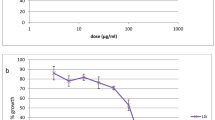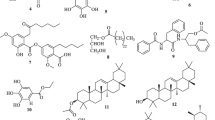Abstract
In order to assess the potential of the stem bark of Kigelia africana (Lam.) Benth as source of new anti-malarial leads, n-hexane and ethyl acetate (EtOAc) extracts and four compounds isolated from the stem bark were screened in vitro against the chloroquine-resistant W-2 and two field isolates of Plasmodium falciparum using lactate dehydrogenase assay. The products were also tested for their cytotoxicity on LLC/MK2 monkey kidney cells. The EtOAc extract exhibited a significant antiplasmodial activity (IC50 = 11.15 μg/mL on W-2; 3.91 and 4.74 μg/mL on field CAM10 and SHF4 isolates, respectively), whereas the n-hexane fraction showed a weak activity (IC50 = 73.78 μg/mL on W-2 and 21.85 μg/mL on SHF4). Three out of the four compounds showed good activity against all the three different parasite strains (IC50 < 5 μM). Specicoside exhibited the highest activity on W-2 (IC50 = 1.54 μM) followed by 2β, 3β, 19α-trihydroxy-urs-12-en-28-oic acid (IC50 = 1.60 μM) and atranorin (IC50 = 4.41 μM), while p-hydroxycinnamic acid was the least active (IC50 = 53.84 μM). The EtOAc extract and its isolated compounds (specicoside and p-hydroxycinnamic acid) were non-cytotoxic (CC50 > 30 μg/mL), whereas the n-hexane extract and two of its products, atranorin and 2β, 3β, 19α-trihydroxy-urs-12-en-28-oic acid showed cytotoxicity at high concentrations, with the last one being the most toxic (CC50 = 9.37 μg/mL). These findings justify the use of K. africana stem bark as antimalaria by traditional healers of Western Cameroon, and could constitute a good basis for further studies towards development of new leads or natural drugs for malaria.
Similar content being viewed by others
References
Adoum OA (2008) Determination of toxicity effects of some savannah plants using brine shrimp test (BST). Int J P App Sci 2(3):1–5
Akeng'a Ayuko T, Njihia Njau R, Cornelius W, Leah N, Ndiege IO (2009) In vitro antiplasmodial activity and toxicity assessment of plant extracts used in traditional malaria therapy in the Lake Victoria Region. Mem Inst Oswaldo Cruz 104(5):689–694
Amusan OOG, Adesogan EK, Makinde JM (1990) Antimalarial active principles of Spathoda companulata stem bark. Phytother Res 10(8):692–693
Bray DH, Warhurst DC, Connolly JD, O'Neil MJ, Phillipson (1990) Plants as source of antimalarial drug. Pt.7 activity of some species of Meliaceae plants and their constituent limonoids. Phytother Res 4(1):29–35
Carvalho LH, Rocha EMM, Raslan DS, Oliveira AB, Krettli AU (1988) In vitro activity of natural and synthetic naphthoquinones against erythrocytic stages of Plasmodium falciparum. Braz J Med Biol Res 21(3):485–487
Clarkson C, Maharaj VJ, Crouch NR, Grace OM, Matsabisa PPMG, Bhagwandin N et al (2004) In vitro antiplasmodial activity of medicinal plants native to or naturalised in South Africa. J Ethnopharmacol 92(2–3):177–191
Geysen HM, Schoenen F, Wagner D, Wagner R (2003) Combinatorial compound libraries for drug discovery: an ongoing challenge. Nat Rev Drug Discov 2(3):222–230
Jachak M, Arvind Saklani (2007) Challenges and opportunities in drug discovery from plants. Sanjay Current Sci 92(9):1252–1257
Jachak SM, Saklani A (2009) Kigelia africana (Lam) Beth—an overview. Nat Prod Rad 8(2):190–197
Koetter U, Kaloga M, Schilcher H (1994) Isolation and structure elucidation of p-Hydroxycinnamic acid esters from the rhizom of Agropyron repens, Part II. Planta Med 60(5):488–489
Lombardino JG, Lowe JA III (2004) The role of the medicinal chemist in drug discovery—then and now. Nat Rev Drug Discov 3(10):853–862
Malebo HM, Tanja W, Cal M, Swaleh SAM, Omolo MO, Hassanali A et al (2009) Antiplasmodial, anti-trypanosomal, anti-leishmanial and cytotoxicity activity of selected Tanzanian medicinal plants. Tanzania J Health Res 11(4):226–234
Masao H, Kue-Ping K, Yue-Zhong S, Yasuhiro T, Tohru K, Tsuneo N (1988) A triterpene from the fruits of Rubus chingii. Phytochemistry 27(12):3975–3976
Nasser JA, Yaacob WA, Din LB, Yamin BM, Latip J (2009) Isolation of atranorin, bergenin and goniothalamin from Hopea sangal. ARPN J Eng Appl Sci 4(1):92–95
Newman DJ, Cragg GM, Snader KM (2003) Natural products as sources of new drugs over the period 1981–2002. J Nat Prod 66(7):1022–1037
Ngemenya MN, Akam TM, Yong JN, Tane P, Fanso-Free SN, Berzins K, Titanji VPK (2006) Antiplasmodial activities of some products from Turreanthus africanus (Meliaceae). Afr J Health Sci 13(1–2):33–39
Nkhoma S, Molyneux M, Ward S (2007) In vitro antimalarial susceptibility profile and Prcrt/Pfmdr-1 genotypes of Plasmodium falciparum field isolates from Malawi. Am J Trop Med Hyg 76(6):1107–1112
Oladele AT, Adewunmi CO (2008) Medicinal plants used in the management of malaria among the Traditional Medicine Practitioners (TMPs) in South Western Nigeria. Afr J Infect Dis 2(1):51–59
Parkurst MR, Thomas AW, Adams TR, Makhubu LP, Mthupha BM, Wolde YL et al (1990) Triterpene aglycones from various Phytolacca dodecandra populations. Phytochemistry 29(8):1171–1174
Razakantoanina V, Nguyen Kim PP, Jaureguiberry G (2000) Antimalarial activity of new gossypol derivatives. Parasitol Res 86(8):665–668
Ridley RG (2002) Medical need, scientific opportunity and the drive for antimalarial drugs. Nature 415(7):686–693
Saxena S, Pant N, Jain DC, Bhakuni RS (2003) Antimalarial agents from plant sources. Current Sci 85(9):1314–1329
Schwikkard S, Van Heerden RF (2002) Antimalarial activity of plant metabolites. Nat Prod Rep 19(6):675–692
Tane P, Wabo HK, Connolly JD (2005) A new benzophenanthridine alkaloid from Zanthoxylum buesgenii. Fitoterapia 6(7–8):656–660
Tetsuo I, Hiroaki A, Tsunao H, Shizuo S, Ronghui S, Nobuyuki H, Mujo K (1990) Monoterpenoids from Rabermachia sinica. Phytochemistry 29(6):1913–1916
Titanji VPK, Zofou D, Ngemenya MN (2008) The anti-malarial potential of medicinal plants used for the treatment of malaria in Cameroonian folk medicine. Afr J Trad CAM 5(3):302–321
Moon H, Jung J, Lee J (2006) Antiplasmodial activity of triterpenoid isolated from whole plants of Viola genus from South Korea. Parasitol Res 100(3):641–644
Chung I, Kim M, Moon H (2008) Antiplasmodial activity of sesquiterpene lactone from Carpesium rosulatum in mice. Parasitol Res 103(2):341–344
Acknowledgements
This work received financial support in the form of research grants awarded to Professor Vincent P.K. Titanji by the International Programme in the Chemical Sciences (IPICS, CAM:01) and Microsoft Corporation, and a research grant from the International Foundation for Science (IFS) awarded to Dr. Mathieu Tene (RGA No. F/4238-1).
Author information
Authors and Affiliations
Corresponding author
Rights and permissions
About this article
Cite this article
Zofou, D., Kengne, A.B.O., Tene, M. et al. In vitro antiplasmodial activity and cytotoxicity of crude extracts and compounds from the stem bark of Kigelia africana (Lam.) Benth (Bignoniaceae). Parasitol Res 108, 1383–1390 (2011). https://doi.org/10.1007/s00436-011-2363-y
Received:
Accepted:
Published:
Issue Date:
DOI: https://doi.org/10.1007/s00436-011-2363-y




